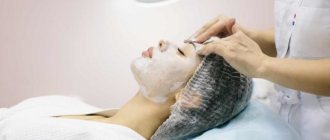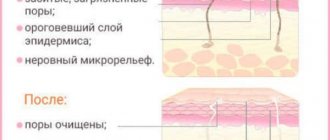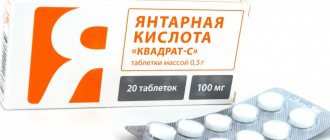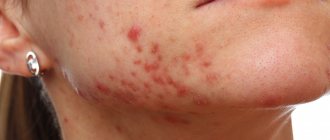Various acids in cosmetics are no longer news, but it still sounds a little scary, especially if you associate acid with chemistry lessons at school. There, during laboratory work, you could see how a whole piece of metal disappears in a small test tube. Don't be afraid, because acids in facial cosmetics are completely different. They are not just safe for our health, but even beneficial for the skin.
When we talk about acids in cosmetics, we mean exfoliation of dead skin cells. Deep peeling, in other words. The advantage of acids is not only this: in addition to the above, acids prevent moisture from evaporating from skin cells, i.e. help maintain skin elasticity and youth. The most famous of the “useful” acids is hyaluronic acid. She is a shining example of not so much exfoliation as nourishment and rejuvenation of facial skin.
Use of acids in cosmetics: why scrub the skin?
We don’t notice it, but our cells constantly live and die, several million per day. These very approximate figures may vary depending on weather and other environmental conditions, as well as diseases and genetic inheritance. If you don't touch the skin in any way, a lot of dead cells will accumulate. This leads to several unpleasant consequences:
- Early appearance of facial wrinkles or deepening of existing ones;
- Dullness and uneven complexion;
- Peeling of the skin, enlargement and clogging of pores.
These and other troubles can be easily eliminated by regular exfoliation of the skin in two ways:
- Mechanical peeling. The essence is to remove the topmost layer of skin, that is, dead cells. This is done with the help of abrasive particles; they can be found in some cosmetics: scrubs, peelings and others;
- Chemical peeling. It works a little differently - due to the presence of various acids in the composition. Like abrasive particles, acids remove the stratum corneum and improve the condition of the skin in general. This kind of cleansing allows nourishing cosmetics to work more effectively and penetrate deeper into the layers of the skin.
Modern dermatologists are increasingly turning to the second option, because it is less traumatic for the skin. In mechanical peeling products, exfoliating particles can be harsh and irritate the skin. Brushes and scrubs cannot give a long-lasting and strong effect, since they act on the very top layer of the skin without penetrating deep. The use of acids in cosmetics, on the contrary, allows the procedure to be considered therapeutic and can have a much more effective effect on the skin. This works by reducing the activity of the sebaceous sweat glands, as well as eliminating hyperpigmentation, post-acne and signs of photoaging, tightening pores, deeply nourishing and moisturizing the skin.
Acne treatment using Azelik® gel
The active substance of Azelik® gel is 15% azelaic acid. In addition, the foundation contains the auxiliary softening and moisturizing component squalane7. Due to the presence of dimethicone in the base, the gel is easily absorbed, and micronization of azelaic acid also contributes to this7.
Azelik® should be used twice a day, morning and evening5. 15% azelaic acid gel can be used both as monotherapy and in combination with other drugs, for example, the topical antibiotic Clindovit®9.
What problems can acids in cosmetics solve?
Acids of various types and stripes are similar in one thing - the principle of operation, namely in the dissolution of dead skin cells. This process frees up space for new cells to appear and reduces the number of dead cells in the future. In simple terms, you purposefully and carefully damage the skin to make the texture smoother and renew the cells. As a bonus, you will make it easier for moisturizing and nourishing products to work - after acid peeling, it will be much easier for the main components to penetrate into the deeper layers of the skin and work easier. In modern cosmetology, several categories of acids are used.
AHA acids in cosmetics
They are obtained from milk and various plants, but most of what we see in cosmetics is artificially created in laboratories. If the concentration of alpha acids is low, they can retain moisture inside skin cells (up to 4%). If more (from 5%), it works like a scrub - exfoliates dead cells.
AHA acids dissolve in water and cannot penetrate deep into the layers of the epidermis. But they work great on the surface itself:
- Exfoliate;
- Remove signs of aging: wrinkles, lack of firmness, radiance, elasticity, etc.;
- Remove hyperpigmentation;
- Fighting post-acne;
- They help collagen and elastin to be produced in the right quantities.
The most popular in this category is glycolic acid, it has been studied from all sides to find out its pros and cons. It is extracted from red cane and is considered the cheapest and most effective. It is also believed that extremely high concentrations of glycolic acid (found only in salon treatments) are very useful in treating advanced stages of acne. In addition, it helps increase collagen production and moisturizes the skin well.
Citric acid in cosmetics often acts not as an active component, but as a preservative or regulator of the acidity of the product. However, in terms of effectiveness and beneficial properties, it is very similar to glycolic. Mandelic acid is difficult to find in cosmetics, as it does not work as effectively and exfoliates less effectively. But mandelic acid is great for people with sensitive skin.
Bha acid list. ABC of beauty: BHA - acids
We continue to talk about the most popular ingredients in cosmetic products so that you can choose the right cosmetics that are right for you. Last time we talked about AHA acids, and today we’ll talk about their close friends – BHA acids. What is it and why do you need this acid - read in our material.
What are B HA acids
There is only one BHA acid (beta-hydroxy acid) - the well-known salicylic acid, which is actively used in the cosmetic industry. It loosens the bond between dead skin cells, effectively exfoliating the skin. As a result, the process of their renewal is accelerated, the thickness of the stratum corneum is reduced, the skin texture is leveled, small wrinkles are smoothed out, the complexion improves and the skin pigmentation lightens.
Since salicylic acid is an aspirin derivative, it has anti-inflammatory properties: reduces inflammation, eliminates redness and improves healing. Thanks to these properties, it is effectively used in the treatment of acne and post-acne.
Unlike AHA acids, which dissolve only in water, BHAs can dissolve and penetrate through the fats located on the surface of our pores into the deeper layers of the skin, affecting inflammation, acne and post-acne.
Benefits and harms of B HA acids
Thanks to its ability to dissolve oils, salicylic acid effectively cleanses the skin of sebum and dirt, as well as unclogs pores and prevents breakouts by neutralizing bacteria in the pores. Other benefits include improved collagen production: BHA protects hyaluronic acid molecules from breakdown, maintaining optimal skin moisture levels. It improves the structure and color of the skin. With regular use of salicylic acid-based products, signs of skin damage from UV rays (hyperpigmentation) disappear, and fine wrinkles disappear.
Salicylic acid is contraindicated for those with dry skin types: the acid tends to dry out the skin a little, so it is best used by those with oily skin. It may also cause irritation or mild burning of the skin.
has anti-inflammatory and antibacterial properties; exfoliates dead cells from the surface of the skin; stimulates skin cell renewal; reduces sebum production; increases skin elasticity; reduce the depth of wrinkles; evens out skin color; lightens pigment spots.
Where are B HA acids found?
cleansers (gels, foams, tonics for washing), products for problem skin (gels, creams, serums); exfoliating products (masks, exfoliants, peelings, etc.).
How to find it on the label
Look for the inscription Salicylic acid in the composition - this is BHA acid (salicylic).
Now you know everything about BHA acid. Its use in cosmetics helps oily and problem skin get rid of acne, effectively cleanses pores, fights blackheads and even lightens age spots. Stay with I WANT so you don’t miss the next material in the “ABC of Beauty” series. See you next Friday!
The use of BHA acids in cosmetics
This group of acids, unlike the previous one, is soluble in fat. This quality allows them to penetrate much deeper into the layers of the skin and cleanse the pores from the inside. They effectively fight acne, acne and act as a preventive measure. The most famous acid in this category is salicylic acid, although it differs in composition from others. As a mono product it has disinfecting and anti-inflammatory properties. Recommended for people with oily skin types prone to inflammation and acne. Like AHA acids, salicylic acid perfectly fights photoaging, hyperpigmentation and perfectly exfoliates the skin.
My wish list of acids
DR DENNIS GROSS SKINCARE ALPHA BETA UNIVERSAL DAILY PEEL (PACK OF 30)
This is a legendary product with AHA acids. You should definitely try it.
NIP+FAB GLYCOLIC FIX NIGHT EXTREME SUPERSIZE PADS (WORTH £24.92)
I managed to try these pads with glycolic and salicylic acid, they were supposed to be extra-strong, against inflammation and so on. In fact, I didn’t see anything from them.
PAULA'S CHOICE SKIN PERFECTING 2% BHA LIQUID EXFOLIANT (118ML)
Legendary acne treatment with salicylic acid. Everyone praises it very much and of course I really want to try it.
PAULA'S CHOICE RESIST SKIN TRANSFORMING MULTI-CORRECTION TREATMENT WITH AZELAIC ACID + BHA (30ML)
Acne remedy contains azelaic and salicylic acids!
Omorovicza Midnight Radiance Mask is a night exfoliating and moisturizing facial mask with salicylic acid, copper gluconate and hyaluronic acid.
And from the silver series I want two products:
- Omorovicza Silver Skin Tonic
- light face cream Omorovicza Silver Skin Lotion
Both products contain niacinamide, colloidal silver and salicylic acid. The cream also contains zinc and hyaluronic acid. The products should be ideal for problem skin, designed to fight inflammation and cleanse the skin.
DeVita, Natural Skin Care, Acne Swabs, 2 oz (60 g)
Tampons for acne











